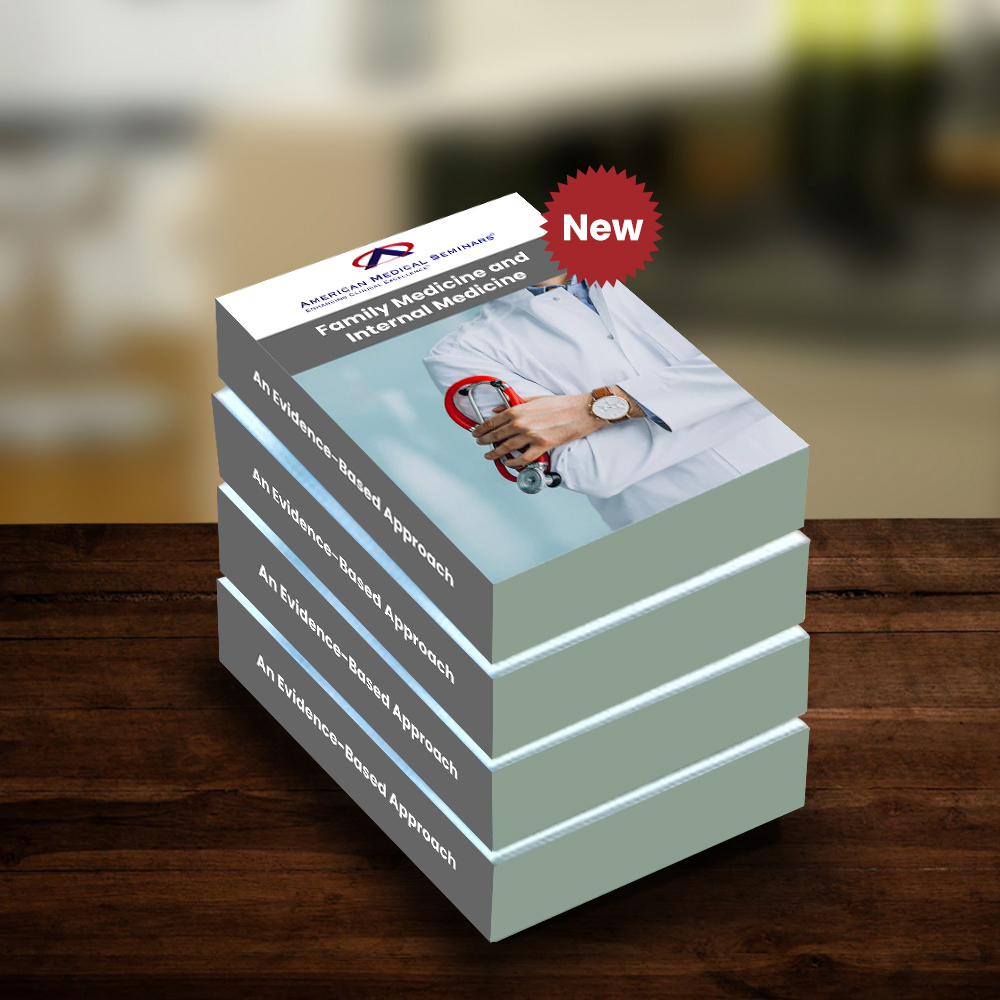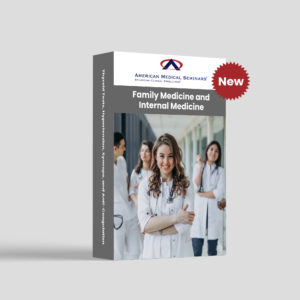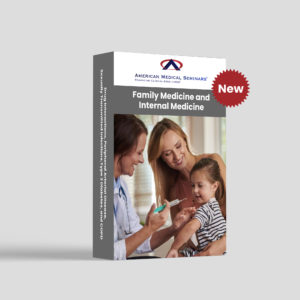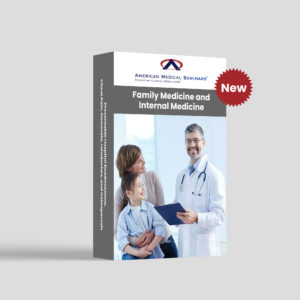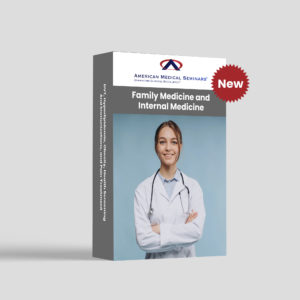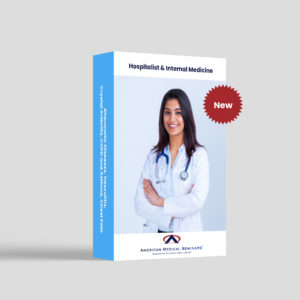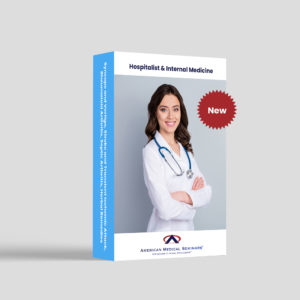Accreditation
AMA
American Medical Seminars, Inc. designates this live activity for a maximum of 20 AMA PRA Category 1 Credits™. Physicians should claim only the credit commensurate with the extent of their participation in the activity.
Accreditation Statement
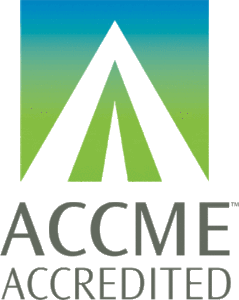 American Medical Seminars, Inc. is accredited by the Accreditation Council for Continuing Medical Education (ACCME) to provide continuing medical education for physicians.
American Medical Seminars, Inc. is accredited by the Accreditation Council for Continuing Medical Education (ACCME) to provide continuing medical education for physicians.
Course Description
Title: 2022 Hospitalist and Internal Medicine: Inpatient and Outpatient Care
Course ID: W-20220829-Family Medicine and Internal Medicine
Faculty: David A. Horowitz, M.D., Herbert L. Muncie, M.D., and Michael P. Goldfinger, M.D., F.A.C.P.
Original Release Date: August 29, 2022 Expiration Date: August 29, 2025
Topic 1: Use and Interpretation of Thyroid Tests Upon completion of this session, the participant should be able to: EBM, COMP
- Integrate the serum tests for thyroid function.
- Interpret thyroid tests results that occur in clinical settings.
- Recommend the appropriate follow-up testing of abnormal thyroid tests and the frequency of these evaluations.
- Appraise the need to treat subclinical hypothyroidism or subclinical hyperthyroidism.
Topic 2: Evaluation and Treatment of Hypertensive Patients Upon completion of this session, the participant should be able to: COMP
- Employ the non-pharmacologic treatment options to manage hypertension.
- Specify the pharmacologic treatment options for patients with compelling indications based upon JNC Guidelines.
- Formulate the therapeutic goal for controlling blood pressure in different patient populations and the combination of medications that can achieve that goal.
- Distinguish the side effect risks for each class of antihypertensive medications.
Topic 3: Evaluation of the Patient with Syncope Upon completion of this session, the participant should be able to: EBM, COMP
- Appraise the various etiologies of syncope.
- Use clues in the history and physical as well as simple office testing to risk-stratify patients with syncope.
- Develop a plan for the appropriate use of additional testing in patients with syncope to include indications for EP testing as per the AHA Syncope Algorithm and the ESC Guidelines.
- Assess the role of lifestyle measures, medication, and more invasive measures to prevent recurrent syncope.
Topic 4: Outpatient Anticoagulation Issues, Part 1 Upon completion of this session, the participant should be able to: GL, COMP
- Manage outpatients on warfarin using current CHEST guidelines and The Joint Commission 2016 National Patient Safety Goals.
- Determine factors leading to alterations in the international normalized ratio (INR).
- Advise patients on the appropriate choice, duration, and intensity of anticoagulation in a variety of clinical scenarios.
- Develop a familiarity with the new oral anticoagulants.
Topic 5: Outpatient Anticoagulation Issues, Part 2 Upon completion of this session, the participant should be able to: EBM, COMP
- Develop an evidence-based approach on perioperative management of antithrombotic and anticoagulant medications.
- Recognize the proper use of IVC filters using evidence-based medicine.
- Develop a practical approach when transitioning patients on and off anticoagulants or switching between anticoagulants.
- Identify appropriate use of anticoagulant and antithrombic medications in combined therapy.
Topic 6: Drug Interactions and Side Effects Upon completion of this session, the participant should be able to: EBM, COMP
- Determine the most common mechanisms for drug interactions.
- Identify some of the most frequent culprit drugs such as Warfarin and Acetaminophen, AED’s, NSAIDs, and Statins.
- Counsel patients regarding some of the most frequent side effects seen with commonly used medications.
- Employ The Joint Commission 2016 Ambulatory Care National Patient Safety Goals.
Topic 7: Peripheral Arterial Disease (PAD) – A Primary Care Perspective Upon completion of this session, the participant should be able to: EBM, COMP
- Assess the relationship between PAD and other forms of atherosclerosis.
- Determine which patients are at increased risk for PAD.
- Perform a focused history and physical examination to assess for PAD.
- Determine when to use ancillary testing.
- Develop a plan for managing patients with PAD utilizing evidence-based ACC/AHA and CHEST guidelines for exercise, medications, and revascularization.
Topic 8: Treatment of Sexually Transmitted Infections Upon completion of this session, the participant should be able to: EBM, COMP
- Determine the appropriate diagnostic testing for complaints suggestive of a sexually transmitted infection.
- Select the therapy for the commonly encountered sexually transmitted infections.
- Formulate the follow-up testing and evaluations for sexually transmitted infections.
- Recommend therapeutic options for preventing herpes simplex infections.
Topic 9: Treating Patients with Type 2 Diabetes Mellitus Upon completion of this session, the participant should be able to: GL, COMP
- Evaluate the therapeutic goals in treating type 2 diabetes and their impact on morbidity and mortality.
- Recommend the approach for choosing an oral hypoglycemic agent to treat type 2 diabetes.
- Specify the clinical situations that would require the use of insulin to treat type 2 diabetes and the probable dosage form and average amounts required for control of A1c.
- Develop the therapeutic options for preventing diabetic complications.
Topic 10: Chronic Obstructive Pulmonary Disease (COPD): Evaluation and Treatment Upon completion of this session, the participant should be able to: EBM, COMP
- Appraise patient specific data to determine if they meet diagnostic criteria for COPD.
- Analyze the role of cigarette smoking in the etiology and natural history of COPD.
- Formulate a treatment plan for the stages of COPD.
- Recommend the follow-up required to assess the therapeutic efficacy of the treatment options.
Topic 11: Strategies to Address the Issue of Preventable Hospital Readmissions Upon completion of this session, the participant should be able to: EBM, COMP
- Identify the factors which contribute to increase risk of readmission.
- Stratify the risk for readmission utilizing evidence-based tools.
- Develop a transition of care strategy to reduce the likelihood of a preventable readmission.
Topic 12: Approach to the Management of Chest Pain Upon completion of this session, the participant should be able to: COMP
- Evaluate the complaint in the context of history, physical exam, and EKG findings.
- Develop a strategy to use cardiac biomarkers in the evaluation of ACS.
- Use recent research studies and guidelines to develop an approach to the patient with chest pain.
Topic 13: Practical Approach to the Patient with Dementia Upon completion of this session, the participant should be able to: EBM, COMP
- Formulate a practical approach to screening for dementia.
- Discuss medication management to include polypharmacy, drug-drug interactions, as well as new drugs and their potential efficacy and side effects.
- Develop a long-term follow-up and referral process that considers cost-effective and resource management.
Topic 14: Migraine Headaches – Update on Diagnosis and Treatment Upon completion of this session, the participant should be able to: GL, COMP
- Construct the approach for evaluating a patient with possible migraine headaches.
- Assess the advantages of supportive therapy and lifestyle changes in treating migraine headaches compared to pharmacologic therapy.
- Appraise the pharmacologic options for treating the acute pain of a migraine headache.
- Recommend a prophylactic therapy regimen for patients with recurrent migraine headaches.
Topic 15: Osteoporosis: Treatment and Prevention Upon completion of this session, the participant should be able to: EBM, COMP
- Debate the importance of the risk factors for an osteoporosis fracture.
- Employ the diagnostic testing for patients at risk with osteoporosis.
- Select the therapeutic medication to treat osteoporosis based upon the indications and side effects.
- Assess the therapeutic role of repeating the DXA scan in patients treated for osteoporosis.
Topic 16: Practical Approach to the Patient with Potential DVT Upon completion of this session, the participant should be able to: EBM, COMP
- Identify the factors which contribute to increase risk of readmission.
- Stratify the risk for readmission utilizing evidence-based tools.
- Develop a transition of care strategy to reduce the likelihood of a preventable readmission.
Topic 17: Practical Approach to the Patient with Hyperlipidemia Upon completion of this session, the participant should be able to: EBM, COMP
- Apply the current NCEP guidelines.
- Develop a practical approach for considering the new medications available.
- Consider the new targets developed for cholesterol end point.
Topic 18: Non-Surgical Approaches to the Patient with Obesity Upon completion of this session, the participant should be able to: GL, COMP
- Review the current popular diets available and marketed to your patients.
- Take into consideration unique needs of the obese patient in order to create a comprehensive approach to the treatment of obesity.
- Explain the basic physiology of obesity.
- Manage the medications available for the treatment of obesity.
Topic 19: Adult Health Screening and Immunizations – Evidence-Based Approach Upon completion of this session, the participant should be able to: COMP
- Apply the evidence-based recommendations for preventive screening tests for adults.
- Determine the immunizations required for adults.
- Appraise the side effects of adult immunizations.
- Select the contraindications for each adult immunization and their alternative therapy.
- Plan when screening tests can be discontinued in adults.
Topic 20: Pain Treatment; Reducing Opioid Abuse; Medication-Assisted Treatment of Opioid Use Disorder Upon completion of this session, the participant should be able to: EBM, COMP
- Implement general principles and goals for the treatment of pain.
- Summarize the best practices for pharmacologic management of acute pain including potential benefits and risks of opioid analgesics.
- Describe the cultural change in approach pain management.
- Discuss the latest guidelines for pain management.
- Apply nonpharmacologic pain management strategies.
- Summarize ways to reduce opioid abuse.
- Describe the treatment options for patients with opioid used disorder.
Topics & Objectives
- The receipt for any incentive-associated purchase will designate the value of the gift card separately from the cost of the learning activity.
- This incentive may have implications on your tax reporting obligations. Any reimbursed amount must be declared as personal income for tax purposes.

